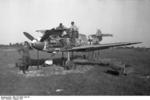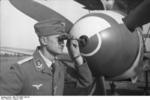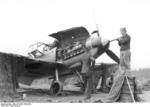20 mm MG-FF Oerlikon Aircraft Autocannon
| Country of Origin | Germany |
| Type | Aircraft Autocannon |
| Caliber | 20.000 mm |
| Length | 1.341 m |
| Weight | 28.000 kg |
| Ammunition Weight | 0.12 kg |
| Rate of Fire | 540 rounds/min |
| Muzzle Velocity | 700 m/s |
Contributor: Alan Chanter
ww2dbaseThis article deals with the German aircraft autocannon variant of the Oerlikon 20-millimeter design. For the design's land and ship-based anti-aircraft applications, please see 20 mm Oerlikon anti-aircraft. For the Japanese variants of the Oerlikon weapon, please see Type 99 Mark 1 and Type 99 Mark 2.
The reconstituted German Luftwaffe entered the war in 1939 with its armament still in a transitional stage. Most German fighter aircraft of the period were still armed with rifle-calibre 7.92mm machine-guns, but, since 1932, the German Air Ministry had been watching with some interest the French use of engine mounted cannon, and had made a request for the development of a fighter that would be armed with two rifle-calibre machine guns and a single 20mm cannon. The initial weapon considered was the large, very powerful but slow-firing Rheinmetall-Borsig MG C/30L, firing through the propeller hub. However, an experiment with a prototype Heinkel He 112 during the Spanish Civil War revealed this installation to be effective only for ground attack and quite unsuitable for aerial combat.
The German engineers then went in the opposite direction and selected the small, low-velocity Swiss FF 20-mm Oerlikon anti-aircraft gun which they would drastically modify so that it could be used in aircraft. This meant making the gun much smaller and lighter, with a faster rate of fire. The engineers achieved this by shortening the barrel and redesigning the 20-mm shells to have similar characteristics to those developed during the Great War for the 1917 model Becker cannon, including reducing the amount of high explosive filling to 50-60 grains of penthrite (less than a third of the 175 grains contained in the contemporary British 20mm Hispano's shells).
The Oerlikon, which was capable of firing a variety of projectiles at low muzzle velocities and at low rate of fire, was of a straight blowback design that permitted the breech-block mechanism to be made considerably lighter. In some respects the German modification was brilliant; the modified gun was made very light and compact, although the design of the breech-block did not incorporate anything to lock it when the shell fired. The explosion in the breech that fired the shell simultaneously opened the breech for the next round. All of this resulted in a very poor muzzle velocity. However, the experts reasoned that since all air combat takes place at close range, and because the missile would actually explode on impact, muzzle velocity was not so very important.
The modified aircraft cannon was put into production by Ikaria Werke Berlin but early attempts to fit it on the engine block of the Messerschmitt Bf.109E to fire through the spinner ran into reliability problems and most aircraft were not fitted with the gun in the field. Many early model Bf.109 fighters still in Luftwaffe service during the 1939 Polish campaign were, in fact, still armed with four machine guns and later "Emil" variants were built with solid spinners instead of the hollow units that should have contained the cannon's barrel. The Messerschmitt Bf.109E-3 which entered service in 1939 and which formed the backbone of German single-seat fighter strength during the Battle of Britain during the summer of 1940, usually mounted two MG-FFs in the wings and a pair of 7.92mm MG 17 machine guns on the engine cowling synchronised to fire through the propeller disc.
The German 20mm MG-FF cannon had some interesting advantages and disadvantages; the guns were more than twice as heavy as the 7.92mm MG 17 and fired only half as fast, about 9 rounds per second. The muzzle velocity was also considerably lower, giving a different trajectory and time-to-target. Also, the limited capacity of its drum magazine limited the weapon to only about 7 seconds of firing. Moreover, the big shells weighed about 12 times as much as rifle-calibre bullets, but their high-explosive filling typically caused significant blast damage as the high-velocity shell fragments penetrated the target. Its other shortcoming was, as stated above, the rate of fire. Fast in comparison to an anti-aircraft weapon, it was slow by the requirements of fighter pilots who could seldom hope to have a target in their sights for more than two seconds (seventeen shells from each of the two cannon). Such a two-second burst consumed well over a quarter of the supply of shells, for even with the Messerschmitt's wings modified by bumps, there was only a meagre 60-round ammunition drum for each cannon.
In May 1940 the Bf.109E-4 entered service with its MG-FF/M gun, adapted to fire the newly developed minengeschoss (mine shell) ammunition. This had very thin walls and a capacity for either high explosive or incendiary filling. As a bonus the shells were much lighter, permitting a higher muzzle velocity. The theory was that solid bullets or armour piercing cannon shells relied on hitting the relatively small vital areas to have an effect, whereas an high explosive shell could cause serious damage regardless of where it struck.
Realizing the limitations of their 20mm Oerlikons, the Germans, from 1941, introduced the 20mm Mauser 151/20, a recoil operated gun with a positively locked breech able to fire a modified MG-FF/M shell which surrendered muzzle velocity (which was now still not far short of the British 20mm Hispanos and with a similar rate of fire) and penetration in the interests of greater destructive effect. The 20mm Oerlikon FF/M, nevertheless continued in service being standard equipment in the Messerschmitt's Bf.110 and early models of the Focke-Wulf Fw.109A. A more notably role however was that of Schräge Musik ("Jazz Music") when a pair of 20mm FF Oerlikons were mounted in a Bf.110 at an angle of 70° to the vertical and situated behind the pilot. The fighter pilot would then fly undetected closely beneath a bomber firing upwards into the belly of his unfortunate target using a special reflector sight. This tactic proved highly effective for shooting down Allied bombers at night who were usually unaware of their approaching predator until it was too late.
Sources:
Anthony G Williams, "Cannon or Machine Gun?" (History in the Air - Aeroplane, September 2004)
Len Deighton, Fighter-The True Story of The Battle of Britain(Triad/Panther, 1977)
Peter Labbett, "German Air Cannon" (War Monthly Magazine) ww2dbase
Last Major Revision: Jun 2015
Photographs
 |  |  |  |
Did you enjoy this article or find this article helpful? If so, please consider supporting us on Patreon. Even $1 per month will go a long way! Thank you. Share this article with your friends: Stay updated with WW2DB: |
Visitor Submitted Comments
2.  David Stubblebine says:
David Stubblebine says:
23 Mar 2014 08:37:56 PM
To #2:
The story of the B-17 "Tondelayo" of the 379th BG, 527th BS (#42-29896) with 11 unexploded 20mm shells in her fuel tanks traces to the book *The Fall of Fortresses* by the aircraft’s navigator, Elmer Bendiner.
More to the point, the 20mm MG FF cannon was standard armament on several Luftwaffe front line fighters. This gun was a derivative of the Swiss Oerlikon.
Also, the standard German anti-aircraft gun was the FlaK 38 (http://ww2db.com/weapon.php?q=c86). The specifications for this gun called it a 2cm gun, which for metric-stupid Americans like me, is exactly 20mm.
The biggest questions arise as one considers the effective range of the FlaK 38 which is 2,400 yards. As an anti-aircraft gun, the FlaK 38 was intended more for low altitude attack-bombers than for high altitude heavy bombers like the B-17.
23 Mar 2014 08:37:56 PM
To #2:
The story of the B-17 "Tondelayo" of the 379th BG, 527th BS (#42-29896) with 11 unexploded 20mm shells in her fuel tanks traces to the book *The Fall of Fortresses* by the aircraft’s navigator, Elmer Bendiner.
More to the point, the 20mm MG FF cannon was standard armament on several Luftwaffe front line fighters. This gun was a derivative of the Swiss Oerlikon.
Also, the standard German anti-aircraft gun was the FlaK 38 (http://ww2db.com/weapon.php?q=c86). The specifications for this gun called it a 2cm gun, which for metric-stupid Americans like me, is exactly 20mm.
The biggest questions arise as one considers the effective range of the FlaK 38 which is 2,400 yards. As an anti-aircraft gun, the FlaK 38 was intended more for low altitude attack-bombers than for high altitude heavy bombers like the B-17.
3. George McClellan says:
24 Mar 2014 11:28:44 AM
David Stubblebine: Thanks for your response. I have to assume that the B-17 in the story was hit by German fighters. I know that the 20 mm was used for defense against low altitude attacks. I think I'm correct in assuming that it was not used against high altitude attacks. Other than Ploesti, B-29 raids on Japan and a couple of others, I know of no low level (7200') heavy bomber attacks. The story doesn't mention any fighter attacks. Maybe I should get the book.
24 Mar 2014 11:28:44 AM
David Stubblebine: Thanks for your response. I have to assume that the B-17 in the story was hit by German fighters. I know that the 20 mm was used for defense against low altitude attacks. I think I'm correct in assuming that it was not used against high altitude attacks. Other than Ploesti, B-29 raids on Japan and a couple of others, I know of no low level (7200') heavy bomber attacks. The story doesn't mention any fighter attacks. Maybe I should get the book.
All visitor submitted comments are opinions of those making the submissions and do not reflect views of WW2DB.
Search WW2DB
News
- » Wreck of USS Edsall Found (14 Nov 2024)
- » Autumn 2024 Fundraiser (7 Nov 2024)
- » Nobel Peace Prize for the Atomic Bomb Survivors Organization (11 Oct 2024)
- » Wreck of USS Stewart/DD-224 Found (2 Oct 2024)
- » See all news
20 mm MG-FF Oerlikon Aircraft Autocannon Photo Gallery
 |
Current Site Statistics
- » 1,150 biographies
- » 337 events
- » 43,917 timeline entries
- » 1,241 ships
- » 350 aircraft models
- » 207 vehicle models
- » 374 weapon models
- » 123 historical documents
- » 260 facilities
- » 470 book reviews
- » 28,541 photos
- » 432 maps
Famous WW2 Quote
"I have returned. By the grace of Almighty God, our forces stand again on Philippine soil."General Douglas MacArthur at Leyte, 17 Oct 1944
Support Us
Please consider supporting us on Patreon. Even $1 a month will go a long way. Thank you!
Or, please support us by purchasing some WW2DB merchandise at TeeSpring, Thank you!
23 Mar 2014 06:54:56 PM
Recent story circulated on the web tells of a B-17 returning to base after a mission with 11 20mm unexploded shells in a fuel tank. Would the Germans have been using this gun against high altitude bombers? I think the story is contrived, but since I know nothing about armaments I won't make a cricism. Thank you.